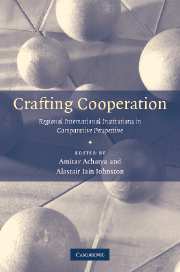Book contents
- Frontmatter
- Contents
- List of tables
- Notes on the contributors
- Acknowledgments
- 1 Comparing regional institutions: an introduction
- 2 Hanging together, institutional design, and cooperation in Southeast Asia: AFTA and the ARF
- 3 International cooperation in Latin America: the design of regional institutions by slow accretion
- 4 Crafting regional cooperation in Africa
- 5 Functional form, identity-driven cooperation: institutional designs and effects in post-Cold War NATO
- 6 Designed to fail or failure of design? The origins and legacy of the Arab League
- 7 Social mechanisms and regional cooperation: are Europe and the EU really all that different?
- 8 Conclusion: institutional features, cooperation effects, and the agenda for further research on comparative regionalism
- Bibliography
- Index
8 - Conclusion: institutional features, cooperation effects, and the agenda for further research on comparative regionalism
Published online by Cambridge University Press: 22 September 2009
- Frontmatter
- Contents
- List of tables
- Notes on the contributors
- Acknowledgments
- 1 Comparing regional institutions: an introduction
- 2 Hanging together, institutional design, and cooperation in Southeast Asia: AFTA and the ARF
- 3 International cooperation in Latin America: the design of regional institutions by slow accretion
- 4 Crafting regional cooperation in Africa
- 5 Functional form, identity-driven cooperation: institutional designs and effects in post-Cold War NATO
- 6 Designed to fail or failure of design? The origins and legacy of the Arab League
- 7 Social mechanisms and regional cooperation: are Europe and the EU really all that different?
- 8 Conclusion: institutional features, cooperation effects, and the agenda for further research on comparative regionalism
- Bibliography
- Index
Summary
By way of conclusion, we want to try to summarize a very rich set of studies. To this end we focus on four issues. First, we look at the variations in institutional design (our first dependent variable) among the regional institutions as a function of variation in the matrix of independent variables identified in the introduction. Second, we look at the variation in the nature of cooperation across regional institutions (our second dependent variable), as a function of institutional design (our first dependent variable now performing as an independent variable). Here we also highlight similarities and differences in the efficacy across regional institutions. Third, we highlight some tentative findings about the relationship between institutional design and the nature of cooperation. And finally, we set out some arguments and suggestions about extending the research agenda on comparative regional institutional design.
Although we presented the contributors with a list of variables on institutional design and indicators of the nature of cooperation, we did not insist that each chapter writer must address each of these variables and indicators. We allowed them the freedom to decide which of these were most relevant to their case study. In short, we recommended, but did not impose, a matrix of variables and indicators. The result, greater autonomy for the contributors, also created the condition for a rich set of empirical studies. But we are able to find important common ground and make generalizations about similarities and differences in meaningful ways.
- Type
- Chapter
- Information
- Crafting CooperationRegional International Institutions in Comparative Perspective, pp. 244 - 278Publisher: Cambridge University PressPrint publication year: 2007
- 1
- Cited by



